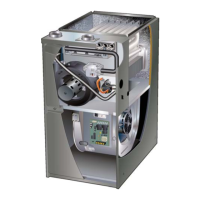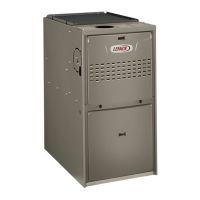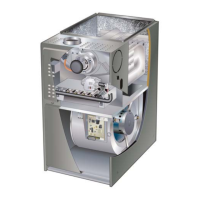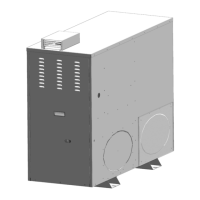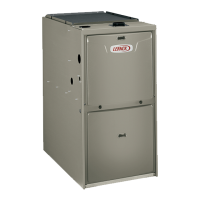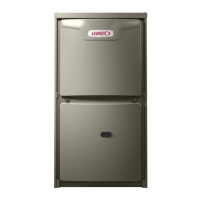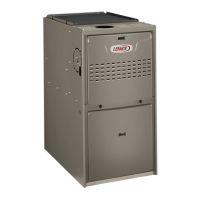Page 24
CAUTION
If this unit is being installed in an application with
combustion air coming in from a space serviced by an
exhaust fan, power exhaust fan, or other device which
may create a negative pressure in the space, take care
when sizing the inlet air opening. The inlet air opening
must be sized to accommodate the maximum volume
of exhausted air as well as the maximum volume of
combustion air required for all gas appliances serviced
by this space.
EQUIPMENT IN CONFINED SPACE
(Inlet Air from Ventilated Attic and Outlet Air to Outside)
NOTE-The inlet and outlet air openings shall each have a free area
of at least one square inch per 4,000 Btu (645mm
2
per 1.17kW) per
hour of the total input rating of all equipment in the enclosure.
Ventilation Louvers
Inlet Air
(Minimum
12 in.(305mm) Above
attic floor)
Roof Terminated
Exhaust Pipe
Furnace
*Intake Debris
Screen
(Provided)
FIGURE 29
NOTE-The inlet and outlet air openings shall each have a free area
of at least one square inch per 4,000 Btu (645mm
2
per 1.17kW) per
hour of the total input rating of all equipment in the enclosure.
EQUIPMENT IN CONFINED SPACE
(Inlet Air from Ventilated Crawlspace and Outlet Air to Outside)
Roof Terminated
Exhaust Pipe
Furnace
Ventilation
Louvers
(Crawl space)
*Intake Debris Screen Provided)
Inlet Air
(Minimum
12 in.(305mm)
Above crawl
space floor)
Coupling or
3 in. to 2 in.
Transition
(Field Provided)
FIGURE 30
General Guidelines for Vent Terminations
In Non-Direct Vent applications, combustion air is taken
from indoors or ventilated attic or crawlspace and the ue
gases are discharged to the outdoors. The ML296UHV is
then classied as a non-direct vent, Category IV gas fur-
nace.
In Direct Vent applications, combustion air is taken from
outdoors and the ue gases are discharged to the out-
doors.
The ML296UHV is then classied as a direct vent, Cate-
gory IV gas furnace. In both Non-Direct Vent and Direct
Vent applications, the vent termination is limited by local
building codes. In the absence of local codes, refer to the
current National Fuel Gas Code ANSI Z223-1/NFPA 54 in
U.S.A., and current CSA-B149 Natural Gas and Propane
Installation Codes in Canada for details.
Position termination according to location given in gure
32 or 33. In addition, position termination so it is free from
any obstructions and 12” above the average snow accu-
mulation.
At vent termination, care must be taken to maintain protec-
tive coatings over building materials (prolonged exposure
to exhaust condensate can destroy protective coatings).
It is recommended that the exhaust outlet not be located
within 6 feet (1.8m) of an outdoor AC unit because the
condensate can damage the painted coating.
NOTE - See table 7 for maximum allowed exhaust pipe
length without insulation in unconditioned space during
winter design temperatures below 32°F (0°C). If required
exhaust pipe should be insulated with 1/2” (13mm) Ar-
maex or equivalent. In extreme cold climate areas, 3/4”
(19mm) Armaex or equivalent may be necessary. Insu-
lation must be protected from deterioration. Armaex with
UV protection is permissible. Basements or other en-
closed areas that are not exposed to the outdoor ambient
temperature and are above 32 degrees F (0°C) are to be
considered conditioned spaces.
IMPORTANT
Do not use screens or perforated metal in exhaust or
intake terminations. Doing so will cause freeze-ups and
may block the terminations.
IMPORTANT
For Canadian Installations Only:
In accordance to CSA International B149 installation
codes, the minimum allowed distance between the
combustion air intake inlet and the exhaust outlet of other
appliances shall not be less than 12 inches (305mm).

